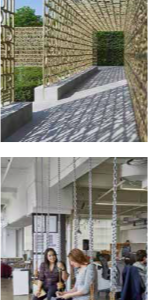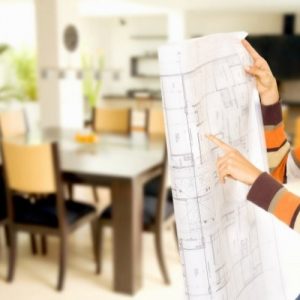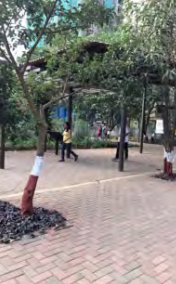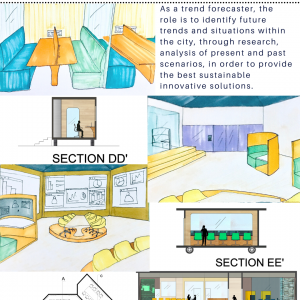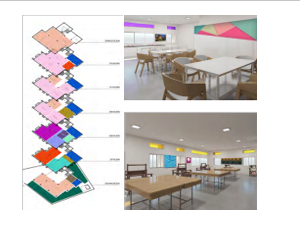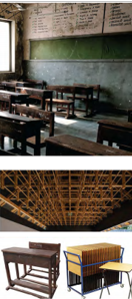Ever wondered what it takes to make the ambience of a hotel, resort, or even hospitals look alive? It is the work of interior landscapers. Yes! You read that right. It is not the architecture but interior landscapers who add aesthetic to the ambience.
To understand how it is maintained for the long term, the energy it brings to the theme of the building and people are the broad areas to be looked at. To add beauty with actual pieces takes a lot of hard work and creativity. Clearly, a landscape is not limited to the area under the structure or the plinth level. Its extension into the interior makes the space look more welcoming and beneficial to the environment.
What is Interior Landscaping?
The practice of designing, installing, and maintaining plants and biophilic components inside buildings is known as interior landscaping. Interior plantscaping or interiorscaping are terms used by industry professionals to describe this service.

All of the components installed in an interior, such as furnishings and art, are referred to as “interior landscape.” The phrase is not used as a technical category in this context, but rather a simple word combination for a headline. Interior landscaping is a term used in the design profession to describe plants, both living and artificial.
A brief history of Interior Landscaping
Since ancient times, Chinese have been growing plants in their homes as a symbol of wealth. They believed that cultivating them would allow people to increase their wealth and provide them harmony along with keeping their loved ones together.
The Hanging Gardens of Babylon were created by King Nebuchadnezzar II for his Queen Amytis. They were filled with plants ranging from date trees to aromatic flowers.
In 1492, Christopher Columbus sailed across the oceans with tropical plants in tow. Since then, anyone who was in the Bahamas or cooler temperatures has been able to enjoy the plants.
House plants didn’t become widely known until the 17th century after Sir Hugh Platt wrote about cultivating them in his book “The Garden of Eden.”
During that period, growing plants indoors was not considered a positive addition to a home. It was believed that they could suffocate a sleeping person due to their carbon dioxide emissions.
By the Victorian era, more people started to introduce houseplants due to the harsh conditions they were living in. Some of these included gas lanterns and coal fires.
Today, due to the advancements in architecture and technology, more people are opting to grow plants in their homes. In England, blue and purple-colored grasses and squiggly ferns were very popular during that period.
Now 100 years later, we are following the same path of our ancestors, however searching for the right course or faculty has been found quite difficult. Hence, ISDI Interior Design program is well designed for beginners to become experts in their landscaping careers.
Evolvement of Interior Landscape in Industry
Within the horticulture sector, interior landscaping is still a small and specialised field. In recent years, Indian horticulture organisations have determined that the specialisation is too tiny to maintain as a category. As a result, there is no professional trade association for interior landscapers to call home at the time of publication. There is also no globally recognised certification programme for the indoor landscape profession to provide education and set standards. As a result, finding a qualified interior landscape designer or contractor can be challenging and complex.
Interior landscaping has shown to be a durable and vital service for building interiors as a mature and specialist industry. Many organisations that concentrate only on internal gardening have been in operation for more than a decade or two.
Building design continues to propel the profession, which arose as a result of a transition in architectural materials from ornamental masonry to floor-to-ceiling glass curtain walls. Plants were needed to soften the stark lines of boxy glass structures in the mid-twentieth century. The abundance of natural light contributed to commercial buildings’ unofficial status as the unofficial home of the obedient office. Modern window glass and artificial lighting assist in providing higher quality light to human occupiers, which plants also benefit from. As a result, interior landscaping remains relevant and significant in architecture and interior design.
Functions of Interior Landscape
Interior landscapes help create a pleasant environment for people and buildings. They are also used to introduce colour and light into spaces.
According to the National Centre for Health Statistics, indoor landscapes can help lower stress and improve a person’s mood. They can also filter out harmful pollutants, such as carbon dioxide.
Creating green spaces through the use of plants is a commitment to sustainable building techniques. It can help lower air pollutants and maintain a cool temperature in open areas.
Interior landscaping is used for commercial applications such as schools, restaurants, and offices.
There are plenty of ways to integrate plants into the home, such as living walls with plants. You can also create small fountains and plants in living areas. But for bigger projects an interior landscaper is a must!
Types of Interior Landscapes Designs:
Green Gardens/Horticulture

Creating a garden interior design can involve the use of various elements, such as fireplaces, seating, and water features. These are usually full of green flowers and plants that are planted in spaces with adequate ventilation and light. They can be arranged in various locations such as courtyard gardens or inside buildings.
They help to keep the environment fresh and energetic by introducing a sense of garden to the house. Having a green garden also helps to create a relaxing and welcoming atmosphere.
Living Walls/Vertical Gardens

These green spaces are usually planted upright for aesthetics, environmental, and space saving purposes. Since they started as part of the green movement, they have become mainstream in modern landscaping. They can also contribute to a building’s LEED rating.
Waterscaping

Water features can be used for both residential and commercial applications. Some of these include ponds, waterfalls, and swimming pools. Hotels and restaurants hire interior landscapers to design their private and common areas with water-based aesthetics.
Floating Indoor Landscaping
A landscape design that is getting popular in India. For instance, a floating garden will include water, a sub-layer to house the plants, and a top layer of edible and attractive flora and fauna that make up floating indoor landscaping. While the beauty of water plants like lilies and lotus is appealing, these floating gardens also provide a home for fish, frogs, and turtles.

These landscapes are not suitable for areas with high humidity levels since they can increase the air humidity levels inside the house. In addition, their designs can create visual disturbances and are not suitable for areas with limited natural light. We have floating restaurants as well.
Stone Scaping
Stone gardens are commonly used in Japanese landscapes to create an atmosphere of peaceful living. They are mainly composed of pebbles and tiles. Massing is achieved through the use of varying stone sizes and shapes. But now it has taken up space in India’s metropolitan cities as well.

Stonescapes can be found in various locations such as courtyard areas, entrance lobbies, and bedrooms. They can be used as areas for relaxation and meditation.
How can ISDI help?
If you are interested in interior designing, then take up Interior Design course as a part of ISDI’s B.Des program. This course will help you develop new skills and enhance your existing ones with industry-based projects.
ISDI offers various design programs that can help you get into a career with practical exposure. The institute’s campus is located in Mumbai, India’s commercial hub. It features a modern, state-of-the-art campus and is run by experienced faculty members from Parsons School of Design.



